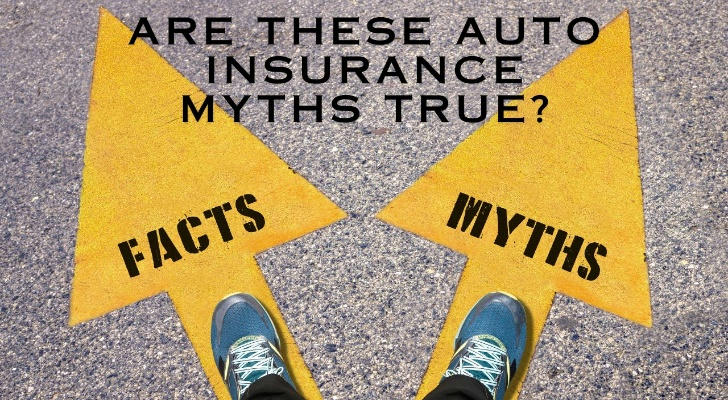Auto Insurance Myths Busted: Save While Staying Covered 🚘
Auto insurance is a necessary expense for most drivers in the United States, but understanding how it works isn’t always straightforward. Despite how commonly it’s purchased, auto insurance is surrounded by myths, misconceptions, and half-truths that can lead consumers to make costly decisions. Whether it's the belief that a red car costs more to insure or the idea that minimum coverage is sufficient for all situations, these myths can influence how people shop for coverage and respond after an accident.
This guide takes a deep dive into the most persistent myths about auto insurance, explaining what’s fact, what’s fiction, and what drivers should actually consider when choosing a policy.

Myth 1: The Minimum State Coverage Is Always Enough
Each U.S. state has its own laws regarding minimum required liability insurance, which typically covers bodily injury and property damage to others when you're at fault. However, these state minimums are often quite low—sometimes as little as $15,000 per person for injury coverage. While this satisfies legal requirements, it’s important to ask: Would that amount be enough in a real accident?
In serious collisions, especially those involving multiple vehicles or significant medical costs, those minimums are likely to fall short. Drivers who rely solely on state minimums may find themselves personally responsible for any damages that exceed policy limits—potentially putting their savings, wages, or even assets like a home at risk.
Truth: Minimum coverage only ensures legal compliance. For actual protection, drivers often need significantly higher liability limits and additional forms of coverage.
Myth 2: Your Car’s Color Affects Your Premium
The idea that red cars are more expensive to insure is one of the most commonly cited auto insurance myths. This misconception likely stems from the belief that red cars draw more attention from law enforcement or that they are inherently driven faster. While it’s true that driving behavior can influence premiums, the color of the vehicle is never a factor in rate calculations.
Insurers base premiums on a wide range of risk factors—including vehicle make, model, safety ratings, engine size, accident statistics, theft rates, and even the ZIP code where the vehicle is primarily parked. Nowhere in this formula does car color appear.
Truth: A red sports car and a gray one of the same model are treated the same by insurers. Risk assessment is data-driven, not color-driven.
Myth 3: Older Drivers Always Pay Less
Age is one of the many factors insurance companies consider when setting premiums, and generally speaking, mature drivers with clean driving records may enjoy lower rates than younger, inexperienced drivers. However, that doesn’t mean all older adults automatically get the best rates. As drivers reach senior age brackets, insurers may also consider health-related risks, slower reaction times, and frequency of claims among certain age groups.
Moreover, life circumstances often change with age. Retirees may drive less, relocate to new areas, or downsize vehicles—all of which can shift risk profiles and premiums.
Truth: Age alone doesn’t guarantee savings. Safe driving history, vehicle use, and location remain critical factors regardless of age.
Myth 4: Comprehensive Coverage Covers Everything
The word “comprehensive” may suggest total protection, but in insurance terms, it has a specific meaning. Comprehensive coverage typically applies to events that are not related to a collision—such as theft, fire, hail, vandalism, animal strikes, or natural disasters. It does not cover damages resulting from hitting another car, pole, or curb.
Many drivers are surprised to learn that comprehensive and collision are two separate forms of optional coverage. Collision covers your own vehicle when you’re at fault in an accident, while comprehensive handles unexpected non-collision losses. Without both, you may face significant out-of-pocket costs for a wide range of common incidents.
Truth: “Comprehensive” is just one piece of a broader protection plan. It doesn’t eliminate the need for other coverages.

Myth 5: Your Insurance Follows the Driver, Not the Vehicle
This myth has led to some costly misunderstandings. If you lend your car to a friend who gets into an accident, many assume the friend’s insurance would cover the damages. In reality, in most states, the vehicle owner’s insurance is considered the primary coverage. That means your policy is responsible first—regardless of who was behind the wheel.
There are some exceptions depending on state laws and the insurance policy’s wording, but in general, allowing someone to use your car means you’re also extending your coverage to them. If the damages exceed your limits, the driver’s insurance may serve as secondary coverage.
Truth: Insurance typically follows the vehicle, not the driver. Lending your car means lending your insurance policy too.
Myth 6: Filing a Claim Always Increases Your Premium
Many drivers hesitate to file insurance claims, fearing it will automatically cause their rates to spike. While certain types of claims—particularly at-fault accidents or multiple claims within a short time—can impact premiums, not every claim leads to a rate hike. For instance, claims involving weather damage or theft may not affect your rates in the same way, especially if you weren’t at fault.
Some insurers offer accident forgiveness programs, where your first at-fault accident won’t impact your premium. Others look at long-term driving history and customer loyalty when determining pricing.
Truth: Premium increases depend on the type, severity, and frequency of claims—not simply the act of filing one.
Myth 7: You Only Need Insurance If You Drive Frequently
Occasional drivers—such as remote workers, retirees, or those who rely on public transportation—sometimes assume they can skimp on auto insurance. But even cars that are rarely driven can be stolen, vandalized, or damaged in severe weather. Parking a vehicle in a garage or private driveway doesn’t eliminate these risks.
Additionally, uninsured cars may not meet state requirements for registration or be protected in the event of damage during that once-a-month drive to the store.
Truth: Low-mileage drivers still face insurance risks. Some insurers offer low-mileage or pay-per-mile policies that can align protection with actual usage.
Myth 8: You Can Rely on Your Credit Score Alone
Another common misconception is that a good credit score automatically leads to low insurance premiums. While credit history is indeed used in many states as a factor in setting rates, it is only one of many criteria. Safe driving, prior claims, vehicle type, and location often weigh just as heavily.
Some states, such as California and Massachusetts, restrict or prohibit insurers from using credit-based scores at all, further reinforcing the point that rates are multi-factorial.
Truth: Credit is part of the equation—but not the whole story. A spotless credit report doesn’t guarantee the lowest rates.
Smart Strategies to Stay Covered Without Overpaying
Understanding what auto insurance doesn’t do is just as important as knowing what it covers. With so many myths and assumptions floating around, it’s easy to be misled or overlook important options.
Here are practical steps drivers can take to make informed decisions:
• Read your policy carefully. Know exactly what each section covers—and what it excludes.
• Reevaluate your policy annually. Life changes, and so do your insurance needs.
• Compare policies from multiple providers. Loyalty doesn’t always mean better rates.
• Look for bundled coverage options. Combining auto with homeowners or renters insurance can offer discounts.
• Ask your insurer about available discounts. These might include safe driver rewards, low-mileage programs, or usage-based tracking.

Case Study: When State Minimums Fall Short
In 2023, a 27-year-old driver from Ohio was involved in a multi-vehicle accident on an icy freeway. Although he carried the state-required minimum liability insurance, which covered up to $25,000 in property damage and $50,000 in bodily injury per accident, the total damages quickly surpassed his policy limits. Emergency care for two other drivers, towing and repairs for four vehicles, and legal fees pushed total costs beyond $130,000.
Because his insurance only covered a portion, the driver was held personally responsible for the remaining balance. He faced a lawsuit, wage garnishment, and long-term credit consequences.
This scenario illustrates how minimum legal coverage may satisfy the law but not the real-world financial fallout of an accident. Having higher coverage limits or an umbrella policy might have protected the driver’s assets and prevented years of financial strain.
Conclusion: Knowledge Is Protection
Auto insurance is more than a legal formality—it’s a financial safeguard. But that protection is only as good as your understanding of it. By separating fact from fiction and proactively managing your coverage, you’re not just complying with the law—you’re protecting your finances, your peace of mind, and your future.
Don’t let myths dictate your insurance decisions. Let the facts guide you to better coverage.
